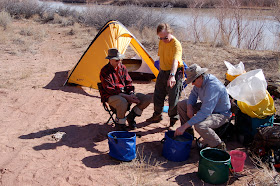BLOG 24 . New WP Bag From Piragis by Cliff Jacobson
I once asked the late Calvin Rutstrum what he thought of synthetic sleeping bags, which dry fast if they get wet. I knew Rutstrum preferred down bags so I expected a baited response. His answer? “Cliff, experienced paddlers donʼt get their sleeping bags wet on canoe trips. If you know how to camp and canoe, you wonʼt either!” I could have cheered!In my writings, Iʼve hammered home that “skills are more important than things”. After all, if you can avoid the accident you wonʼt have to treat it. Still, bad stuff happens. Once, my tundra camp was pelted by driving rain and sustained winds of 60 miles an hour (we had a wind gauge), for three days. Our tents held; nothing got wet. On a wilderness canoe trip to James Bay in 1972, my canoe capsized while it was being lined around a ledge. Our packs were soaking wet but the contents were dry. Hood River, 1992: Susie and I were napping (in our canoe) in an eddy above a narrow rapid, waiting for our turn to run. Suddenly, the current caught the stern and seconds later we were upside down. We were rescued quickly; everything in our packs was bone dry.
Before the days of dry bags, waterproofing consisted largely of packing by the “sandwich method” described in my books. Basically, you start by stuffing the item into a nylon stuff sack (which need not be waterproof). This stuff sack is placed inside a waterproof plastic bag—the bag should be twice the length of the stuff-sack. You twist (spindle) the mouth of the plastic bag, fold it over and secure it with a bungee cord. This (now waterproof) unit goes inside an over-sized nylon stuff sack. Note that the waterproof layer (the plastic bag) is sandwiched between tough nylon on each side. This system is 100 percent reliable. A similar procedure, using two giant 6 mil thick plastic bags, is used to waterproof large portage packs. However, 6-mil bags donʼt “twist, and bungee” as easily as lighter bags, so the best procedure is to separately roll down the mouth of each bag then buckle the pack-flap tightly enough to compress the rolled plastic liners below. The liner bags must be compressed to be water-tight. The negative is that you need a nearly full pack to maintain sufficient pack-flap compression.
 |
| Cooke Custom Sewing Pioneer pack and Piragis waterproof liner bag |
Enter the new bright yellow “Piragis nylon Waterproof Pack Liner”. Constructed from PVC-free, urethane-coated nylon (with welded seams), this heavy-duty waterproof bag measures 48 inches high by 29 inches wide. This is big enough to fill out the largest portage pack. A rectangular bottom uses space efficiently. The classic roll-and-Fastex buckle closure is quick and secure. When sealed, the liner is completely watertight—no need for compression. The coated nylon fabric is cold-flexible and very tough. This said, Iʼm a belt-and-suspenders man so I always place a 6-mil plastic liner bag INSIDE the waterproof pack liner to take the abrasion that comes from stuffing things into the yellow bag. A plastic liner bag prevents damage to the waterproof coating of the yellow bag when you stuff.
 |
| Green River, Utah. Note yellow waterproof bags and plastic liners |
The Piragis Waterproof Pack Liner is an excellent product; I
heartily recommend it!
Cliff Jacobson
www.cliff-jacobson.com
No comments:
Post a Comment